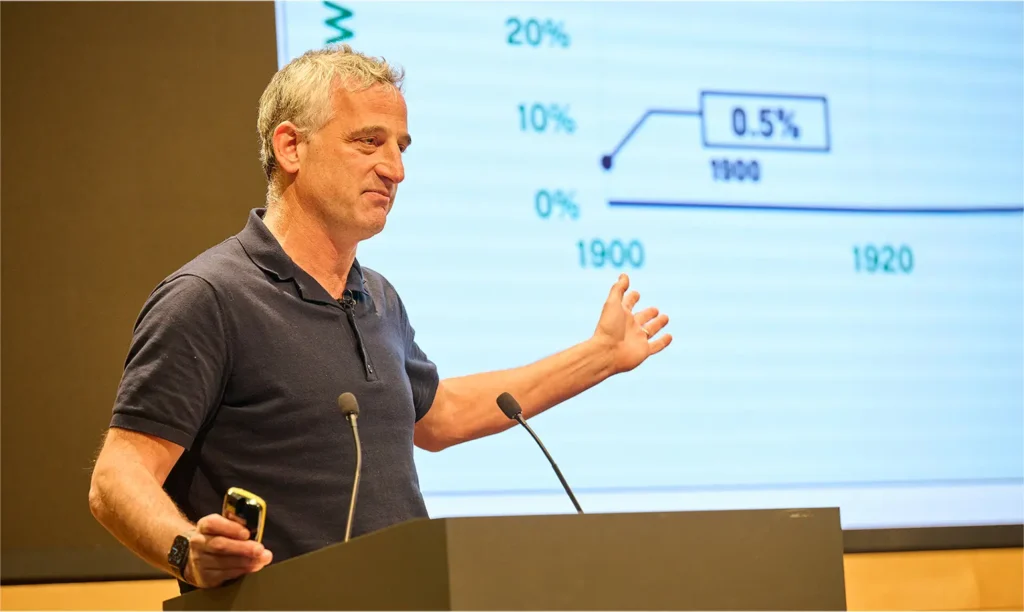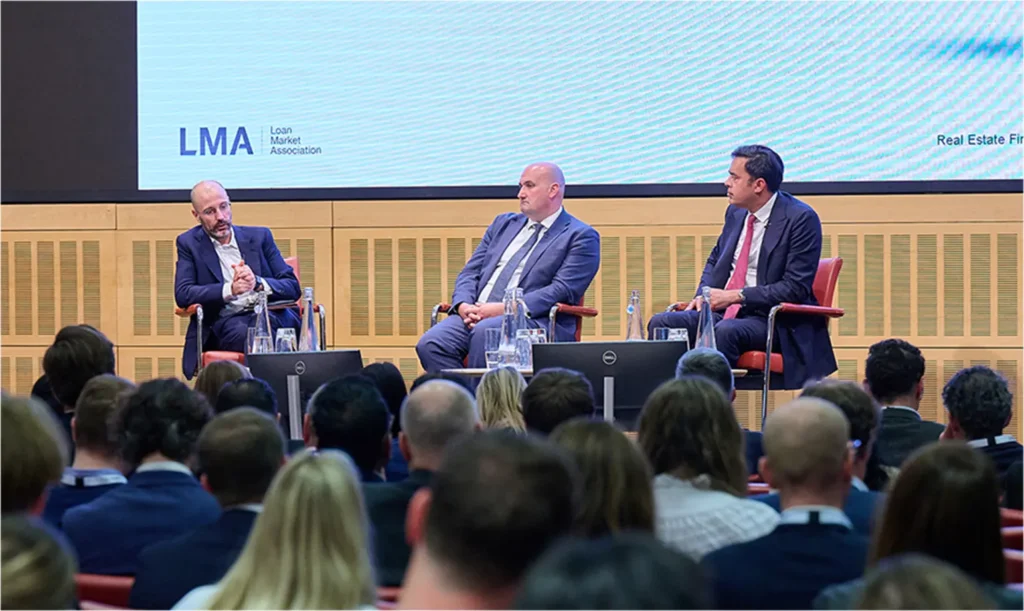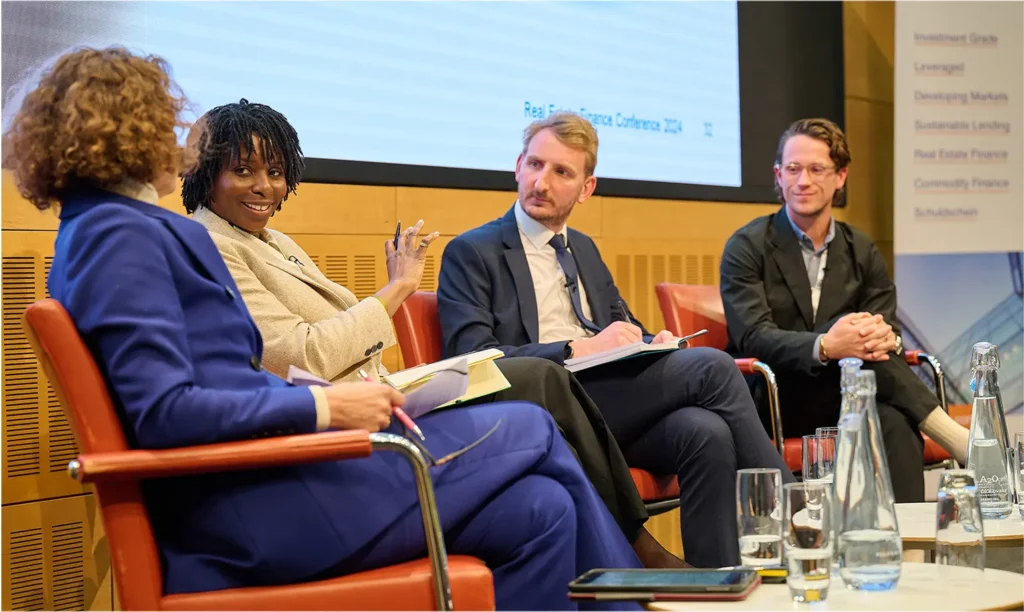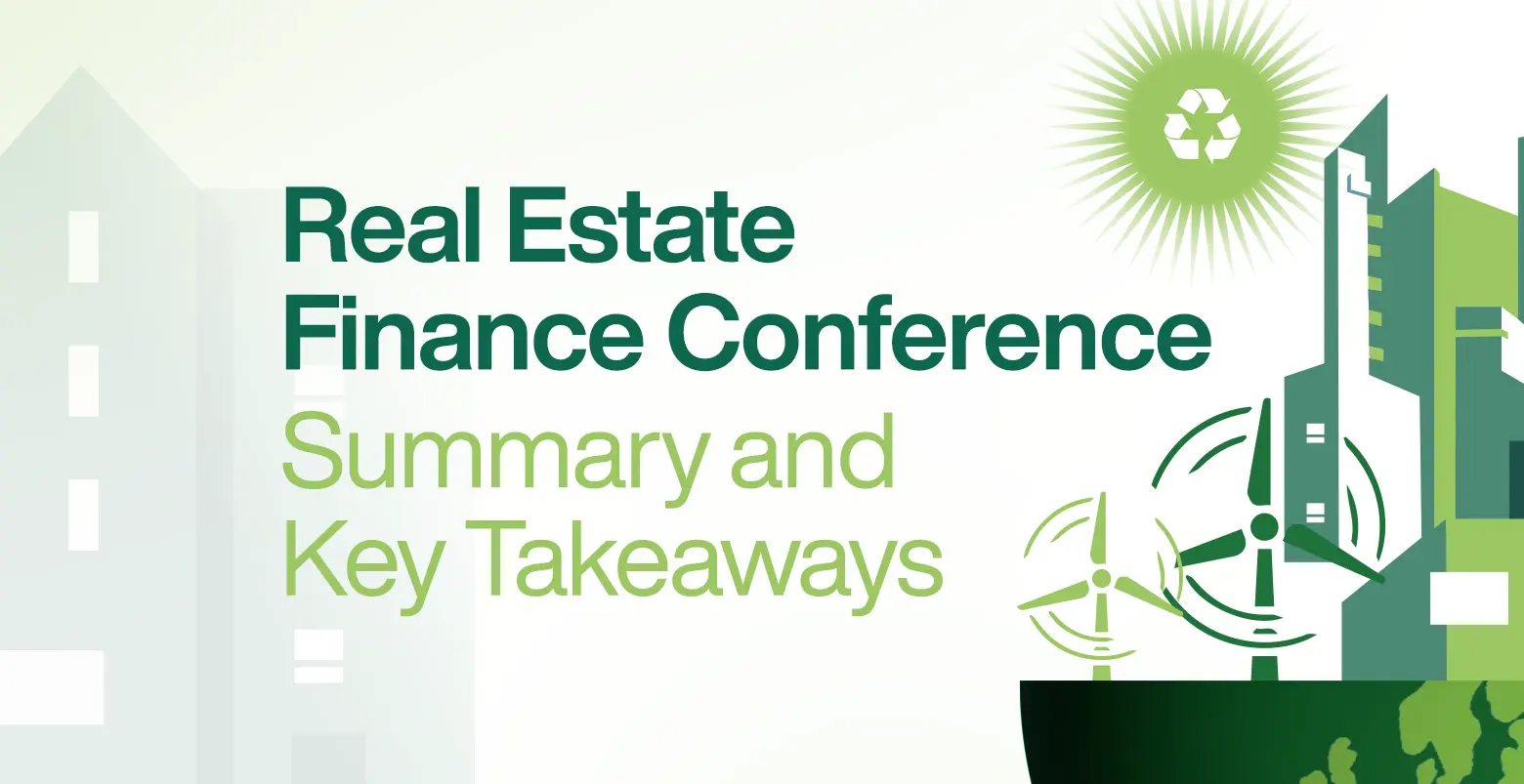On 24 April 2024, the Loan Market Association (LMA) hosted its annual Real Estate Finance Conference, attracting nearly 400 market participants from across the real estate finance industry including lenders (bank and non-bank), investors, developers and advisors.
In an action-packed afternoon, our line-up of expert panelists shone the spotlight on the future of the real estate finance market and, in doing so, tackled some of the big questions facing the industry today. And, in classic British fashion, of course, the conversation turned to the weather…
Scott McMunn, CEO of the LMA, began the day by looking back before turning to the outlook for the market.
Reflecting upon his first 6 months at the LMA, Scott noted that his vision was for real estate finance to be a continued area of focus for the LMA going forward. Despite recent challenges faced by the sector, Scott noted that there were still plenty of reasons for optimism in the market – with strong resilience being displayed in the wake of the ever-changing macroeconomic and geopolitical environment. The LMA’s role was, as he saw it, to assist market participants with navigating these challenges (including through the publication of its recent guidance note on the Building Safety Act 2022) and providing a voice for the industry on key market issues.
Scott further noted that promoting growth and innovation, as well as encouraging liquidity, transparency and efficiency, were key strategic goals for the LMA in 2024. The LMA’s new flagship conference, FutureLend, would therefore be taking place on 22 May 2024 with the aim of empowering and inspiring young lenders and bankers with a shared passion for finance. Scott urged interested members to get in touch to find out more.

Keynote
Jonathan Simmons, social entrepreneur, challenged the audience as part of his keynote address to think about what their local businesses mean to them.
He noted that in each village, suburb or city, there are a handful of local businesses that often act as a cornerstone of local identity and belonging. Indeed, feeling a part of your local community remains of vital importance to most people today and, therefore, the high street can in many instances deliver tangible social value. However, with wealth inequality rising and funding costs increasing, Simmons noted that these small businesses are often struggling to survive due to increased costs (such as rent increases) and lack of access to capital.
So, can the loan market offer solutions to help these businesses weather the storm? Well, that was the call to action from our keynote speaker. Simmons challenged delegates to think about how they might do things differently – channelling capital into businesses at the heart of communities through innovative long-term local funding structures. It was a thought-provoking session and flagged a key question about the interaction between the built environment and social value creation – a key theme which was explored by speakers throughout the day.

REF Market Update
Henri Vuong, Executive Director and Head of Debt Investment Research at PGIM, took to the stage next to set the scene on the status of the real estate finance market, and to give her forecast for the future.
Vuong set the scene by recapping that in the past, the sharp rise in interest rates had significantly increased the cost of borrowing against real estate assets, with costs of financing surpassing prime property yields in many cases. However, as yields moved out borrowing costs and prime yields are starting to move closer together.
She noted that there was a renewed optimism going into 2024, with successive rate cuts widely predicted. However market sentiment has since shifted towards an expectation that interest rates would now fall at a much slower pace than previously anticipated. However, any cuts to base rates should stimulate economic growth, leading to rental growth, increases in values and improvements in returns.
On valuations, Vuong noted commercial real estate values were generally expected to hit a trough this year before rising, leading to debt becoming accretive once again, especially as rates start to fall. As debt becomes accretive, Vuong said that the market will move towards positive leverage territory, with yields once again higher than coupon costs.
Over the next three years, Vuong noted that Europe faces $950 billion in maturing loan volumes, posing a refinancing challenge for the market, though an opportunity for non-bank lenders.
Loan-to-value ratios on senior loans have been trending down in recent years, which is partly a result of a stringent regulatory environment post-GFC, in turn meaning that the market is far less leveraged than before the global financial crash.
With regulated lenders constrained by capital retention rules, Vuong predicted that in the face of the looming maturity wall borrowers were likely to diversify their sources of capital, meaning non-bank lenders would be likely to play an increasingly active role in the real estate finance market.

Lending Landscape in 2024: What’s Next?
Omega Poole (Chair), Head of Funds Management at LendInvest Capital, was joined by Gordon Milnes, Head of Syndication – Investec, Arron Taggart, Head of UK Investment – Cheyne Capital, Craig Prosser, Managing Director, Head of UK Real Estate finance Origination – LBBW and Klaus Betz-Vais – Head of Global Investors & Listed, Real Estate & Housing, Managing Director – Lloyds Banking Group for our lending landscapes panel.
Before diving into a lively debate about the outlook for the market, there was an opportunity for our panel to take the temperature of the room – with most delegates surveyed feeling cautiously optimistic about the prospects for the next 12-18 months.
The panel noted that whilst things were looking less stormy overall, it was also a very localised picture with the outlook depending heavily on both the asset quality and location.
An interesting development was increasing fluidity in the definition of primary and secondary assets, with perceptions affected by major shifts within office and residential asset classes. Office in particular posed a challenge as an asset class where sustainability considerations were at the forefront of corporate strategies. Accordingly, whilst the value of older assets was often depreciating due to the cost of renovation work to meet green standards, there was a premium emerging for top performing real estate in prime locations (such as the West-End).
The panel agreed that transaction volumes are likely to pick up in the latter half of 2024, with a number of maturity walls being reached and a need for lenders to exit certain loans. Nonetheless, it was agreed transaction volumes would likely still be down significantly on 2021 volumes.
So, is there a risk that a storm may still be on the horizon in 2024? Well, our panel certainly hoped not and shared some of the cautious optimism of the audience. The biggest risks for the real estate finance market in the future will however continue to come from geopolitical risks and macroeconomic uncertainty.

Distressed debt and NPLs in the Real Estate Finance Market
Next up, Joel Ferguson, (Partner at Allen & Overy) was joined by Jan Duedden, Managing Partner, Arcida Advisors GmbH and Oliver Haunch, Partner, Grant Thornton for their views on whether a wave of distressed debt and NPLs is about to hit in the real estate finance market.
With a significant volume of debt coming up for refinancing in the next few years and higher borrowing costs, an uptick in restructuring activity was widely predicted by both the audience and the panelists. However, so far, the predicted surge in distressed debt and NPLs had not yet been seen in either the UK or German real estate finance markets. This is partly down to sponsors injecting more equity or agreements to sell non-performing assets behind the scenes.
Mirroring comments from our earlier panel, it was noted that transaction volumes were still low. The German market was seen as being particularly illiquid, with very little activity against which to provide valuations for lenders in the market. The panel agreed that regulatory environment for banks meant that it was unlikely we would see NPL portfolio sales on the levels seen post-GFC. Whether or not parties would take action to enforce their loans would, however, depend on their position in the capital stack.
An interesting point that was noted was that we experienced an almost unprecedented period of calm in the real estate finance market from the period following the global financial crash until the recent hike in interest rates. The result was that most lenders had scaled back, got rid of, or (in the case of non-bank lenders) never put in place, restructuring teams. As a result, lenders may not have internal teams with experience of dealing with workout/enforcement scenarios. Our panel advised that lenders may therefore need to take early action to work with external experts to assess all available options in a distressed debt scenario.

Fireside chat: Olaide Oboh, Socius
Social value a key theme running throughout this dedicated interview with Susan Freeman, Partner at Mishcon de Reya and Host of Propertyshe podcast, and Olaide Oboh, Director of Social Impact at Socius (a B-Corp).
As a people-driven organisation, Socius ensures that the community are given a seat at the table during any development planning stages. By consulting with local communities, Socius aims to build long-term and trusted relationships, in which the organisation can gain a true understanding of the needs of local residents and how to improve their community wellbeing.
Oboh noted that the development they are delivering in Cambridge with Railpen, Devonshire Gardens, provided a good example of how to deliver social value through their work. Cambridge has one of the highest rates of wealth inequality in the UK, with many members of the community unable to afford housing, and forced to commute long distances to work in the city. Through an in-depth consultation with the local community, a number of key issues had been identified by Socius, including: high levels of traffic; lack of green spaces; and childhood obesity. Socius and Railpen therefore developed the Devonshire Gardens project as a mixed-used space – balancing the revenue-earning commercial buildings with affordable housing and a community nursery. The partnership also transformed 50% of the space into a public park, with community allotments partnered with a local community kitchen to promote healthy eating.
It was an inspiring discussion, offering a refreshing take for market participants looking for a new way to approach business and to drive social value delivery through the built environment.

Sustainability standards for real estate: do we have the right tools yet?
As the chair of our final panel, Louise Ellison, Managing Director, Sustainability at EQT Partners, kicked off a lively discussion on sustainability standards for real estate with a stark reminder that the built environment contributes to a large proportion of global GHG emissions (around 40%). Real estate could perhaps therefore be considered as a hard-to-abate sector for this reason. Nevertheless, being part of the problem means that the real estate industry also has the opportunity to be part of the solution.
Adam Baranowski, Head of Climate Action & Investment at Better Building Partnership, noted the availability of frameworks in the market such as NABERS UK and the upcoming UK Net Zero Carbon Buildings Standard, which could be used by market participants. Chinyelu Oranefo, Director at Lloyds Banking Group and Edward Vaughan Dixon, Head of Responsible Investment for Real Assets at Aviva Investors provided their insights on how lenders are using the available tools in practice to drive real change in the built environment. Oranefo explained Lloyds’ net zero goals, including a 48% reduction target by 2030 and further noted that a range of tools would be used as part of this process including climate transition plans, PCAF/CRREM related pathways, and focus on just transition (re-skilling, affordability, community engagement). It would be difficult to reach these ambitious targets, she noted, but the industry needed to work collectively to seek to drive change. Dixon echoed the benefits of collective action and shone a light on a number of innovative approaches being taken at Aviva Investors to drive decarbonisation and promote biodiversity, including through the firm’s afforestation efforts.




